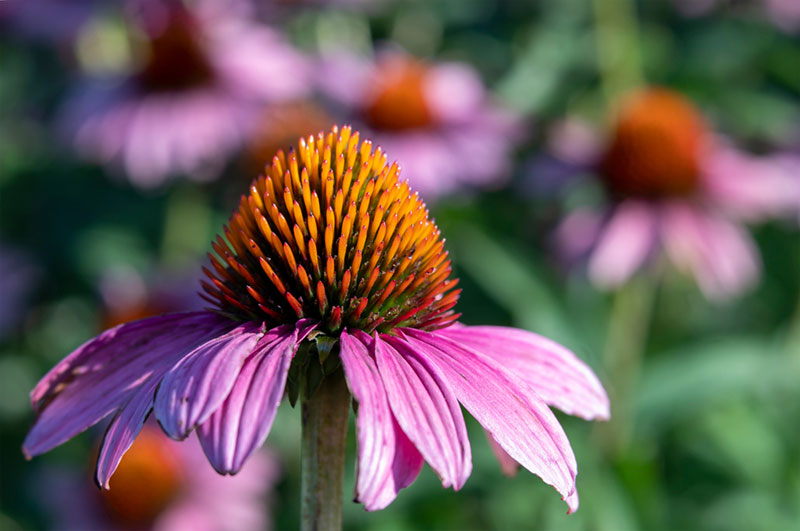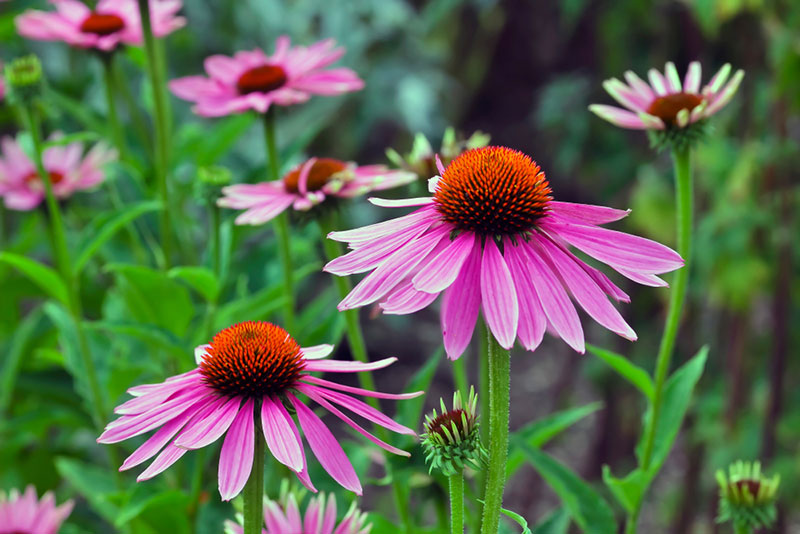There are many varieties of coneflowers. These long-stem flowers that are members of the aster family look like a daisy in most cases because of the way that the rays surround a center disc.
You can divide coneflowers into echinacea that will grow from zone 3 to 9 and rudbeckia that grow from zones 2 to 11.
The great news is that once you learn to take care of one coneflower, you will find it easy to take care of almost all other coneflowers.
Light and Temperature Requirements
Most coneflowers love the sun. Therefore, you should plant them where they get at least six hours of sunlight daily. If you live in zones 9 and above, most will benefit from shade in the afternoon if you want to keep them looking great longer.
While you can jump-start your growing of coneflowers by starting seeds inside, you need to wait until after the last hard freeze to plant them outside. It is best to wait until the average daily high is about 65 degrees. Most varieties will self-seed, so you may not need to plant them at all.
Watering
Most types of coneflowers need at least 1 inch of water per week. Consider giving the plant a little extra water on the hottest weeks of the summer. If it does not rain, use a soaker hose to water your coneflowers deeply once a week. Avoid overhead watering as this can start powdery mildew forming. It is hard to overwater them if they do not stand in soggy soil.
Soil
In an ideal world, you will plant your coneflowers in fertile soil that you have added organic matter too, but the great news is that most types of coneflowers are not picky. They will even grow in rocky soil if they can get their roots down, so avoid soil that is too heavy.
Fertilizer
Just before the emergence of new leaves in the early spring, you should fertilize your coneflowers with a 12-6-6 time-release fertilizer at the rate of one-pound per100-square-feet.
You may also want to cover the top of the area where your coneflowers are planted with 1-inch of compost in the spring. Then, put 2-to-3-inches of organic mulch on top of that.

Pruning
Remove flowers after they are done blooming down to the first leave or branching stem. Deadheading will encourage more blooms to form.
Every two to three years, dig up your original coneflower. Then, divide it into two to three bunches, making sure that each group has some good roots. Then, replant each group. In the process, throw away the plant’s old core.
Propagation
Coneflowers are perfect flowers. The male part produces the pollen, which is accepted by the female part through the pistil.
When the flower has finished blooming, leave the flower head on the plant to go to seed. The seeds that are not carried away by birds for winter food will grow new plants in the spring.
Diseases and Pests
Coneflowers are relatively healthy plants, but you still need to watch for a few problems to stop them quickly. By being aware, you may even be able to stop some of them before they start.
Powdery mildew on a plant will make it look like you have dusted it with talcum powder. The best way to prevent it is to make sure that each plant gets enough sunlight by planting them at least 18-inches apart. Always water from the bottom. If these tips are not enough, then use a fungicide to kill the mildew before it spreads.
Japanese beetles can be a problem for coneflowers. If you see leaves with only the veins remaining, then Japanese beetles may be to blame. They will usually attack in June. The most effective way to get rid of them is to hand-pick them off plants, but that can be very time-consuming. You may want to try spraying your plants with Neem Oil.
Coneflowers are a beautiful addition to your landscaping. Once established, they need very little care. Watch for powdery mildew and Japanese beetles. Deadhead plants to encourage more blooms, and you can enjoy this plant for many years as they self-seed. With the wide variety of choices available, this may be the only plant you need for sunny locations in your landscaping.




